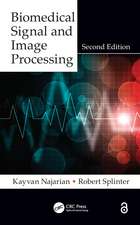Handbook of Inductively Coupled Plasma Mass Spectrometry
Autor K. E. Jarvisen Limba Engleză Paperback – 26 oct 2012
Preț: 404.67 lei
Preț vechi: 425.96 lei
-5% Nou
Puncte Express: 607
Preț estimativ în valută:
77.43€ • 81.06$ • 64.07£
77.43€ • 81.06$ • 64.07£
Carte tipărită la comandă
Livrare economică 05-19 aprilie
Preluare comenzi: 021 569.72.76
Specificații
ISBN-13: 9789401053556
ISBN-10: 9401053553
Pagini: 396
Ilustrații: XI, 380 p.
Dimensiuni: 152 x 229 x 21 mm
Greutate: 0.53 kg
Ediția:1992
Editura: SPRINGER NETHERLANDS
Colecția Springer
Locul publicării:Dordrecht, Netherlands
ISBN-10: 9401053553
Pagini: 396
Ilustrații: XI, 380 p.
Dimensiuni: 152 x 229 x 21 mm
Greutate: 0.53 kg
Ediția:1992
Editura: SPRINGER NETHERLANDS
Colecția Springer
Locul publicării:Dordrecht, Netherlands
Public țintă
ResearchCuprins
1 Origins and development.- 1.1. Introduction.- 1.2 The ICP-MS system.- 2 Instrumentation for ICP-MS.- 2.1 The inductively coupled plasma.- 2.2 Ion extraction.- 2.3 Ion focusing.- 2.4 Quadrupole mass spectrometers.- 2.5 Other mass spectrometers.- 2.6 Ion detection.- 2.7 Vacuum considerations.- 3 Instrument options.- 3.1 Introduction.- 3.2 Nebulisers.- 3.3 Spray chambers.- 3.4 Torches.- 3.5 Interface.- 4 Sample introduction for liquids and gases.- 4.1 Introduction.- 4.2 Electrothermal vaporisation.- 4.3 Vapour generation and gas phase sample introduction.- 4.4 Liquid chromatography.- 4.5 Flow injection.- 4.6 Direct sample insertion.- 5 Interferences.- 5.1 Introduction.- 5.2 Spectroscopic interferences.- 5.3 Non-spectroscopic interferences.- 6 Calibration and data handling.- 6.1 Introduction.- 6.2 General concepts.- 6.3 Instrumental modes of data collection.- 6.4 Linearity of response.- 6.5 Blanks.- 6.6 Factors affecting signal stability.- 6.7 Qualitative analysis.- 6.8 Semi-quantitative calibration.- 6.9 Quantitative analysis.- 7 Sample preparation for ICP-MS.- 7.1 Introduction.- 7.2 General considerations.- 7.3 Digestion procedures.- 7.4 Separation and pre-concentration methods.- 7.5 Conclusions and overview.- 8 Elemental analysis of solutions and applications.- 8.1 Introduction.- 8.2 Multi-element determinations.- 8.3 Geological applications.- 8.4 Environmental applications.- 8.5 Nuclear applications.- 8.6 Industrial applications.- 8.7 Biological applications.- 8.8 Summary.- 9 The analysis of natural waters by ICP-MS.- 9.1 Introduction.- 9.2 Water sampling procedures for ICP-MS.- 9.3 Direct water analysis by ICP-MS.- 9.4 Water analysis with chemical separation and/or pre-concentration.- 9.5 Calibration strategies.- 10 Analysis of solid samples.- 10.1 Introduction.- 10.2 Slurry nebulisation.- 10.3 Laser ablation.- 10.4 Direct sample insertion.- 10.5 Powdered solids.- 10.6 Arc nebulisation.- 11 Isotope ratio measurement.- 11.1 Introduction.- 11.2 Instrument performance.- 11.3 Applications and methods of isotope analysis.- Appendices.- Appendix 1 Originators of reference material cited in the text.- Appendix 2 Naturally-occurring isotopes—useful data.- Appendix 3 Glossary.- References.












